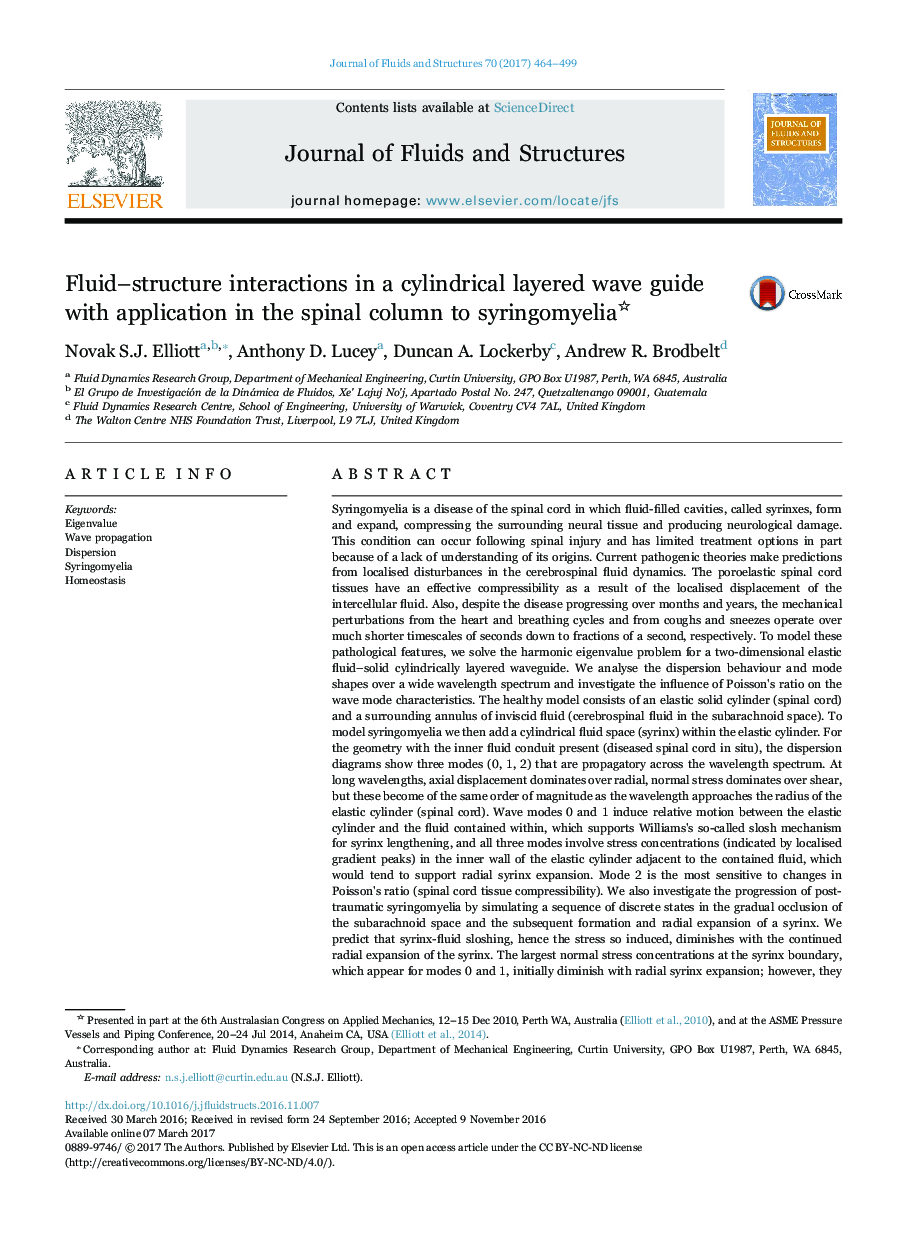| کد مقاله | کد نشریه | سال انتشار | مقاله انگلیسی | نسخه تمام متن |
|---|---|---|---|---|
| 5017441 | 1466577 | 2017 | 36 صفحه PDF | دانلود رایگان |
- Solve harmonic eigenvalue problem for 2D layered fluid-solid cylindrical waveguide.
- Identify wave propagation characteristics of 3 modes from dispersion diagram.
- Mode shapes show relative motion between fluid and solid layers.
- Mode shapes show stress concentration in inner wall of elastic solid layer.
- Syrinx growth may be part of homeostatic mechanism to reduce stress in spinal cord.
Syringomyelia is a disease of the spinal cord in which fluid-filled cavities, called syrinxes, form and expand, compressing the surrounding neural tissue and producing neurological damage. This condition can occur following spinal injury and has limited treatment options in part because of a lack of understanding of its origins. Current pathogenic theories make predictions from localised disturbances in the cerebrospinal fluid dynamics. The poroelastic spinal cord tissues have an effective compressibility as a result of the localised displacement of the intercellular fluid. Also, despite the disease progressing over months and years, the mechanical perturbations from the heart and breathing cycles and from coughs and sneezes operate over much shorter timescales of seconds down to fractions of a second, respectively. To model these pathological features, we solve the harmonic eigenvalue problem for a two-dimensional elastic fluid-solid cylindrically layered waveguide. We analyse the dispersion behaviour and mode shapes over a wide wavelength spectrum and investigate the influence of Poisson's ratio on the wave mode characteristics. The healthy model consists of an elastic solid cylinder (spinal cord) and a surrounding annulus of inviscid fluid (cerebrospinal fluid in the subarachnoid space). To model syringomyelia we then add a cylindrical fluid space (syrinx) within the elastic cylinder. For the geometry with the inner fluid conduit present (diseased spinal cord in situ), the dispersion diagrams show three modes (0, 1, 2) that are propagatory across the wavelength spectrum. At long wavelengths, axial displacement dominates over radial, normal stress dominates over shear, but these become of the same order of magnitude as the wavelength approaches the radius of the elastic cylinder (spinal cord). Wave modes 0 and 1 induce relative motion between the elastic cylinder and the fluid contained within, which supports Williams's so-called slosh mechanism for syrinx lengthening, and all three modes involve stress concentrations (indicated by localised gradient peaks) in the inner wall of the elastic cylinder adjacent to the contained fluid, which would tend to support radial syrinx expansion. Mode 2 is the most sensitive to changes in Poisson's ratio (spinal cord tissue compressibility). We also investigate the progression of post-traumatic syringomyelia by simulating a sequence of discrete states in the gradual occlusion of the subarachnoid space and the subsequent formation and radial expansion of a syrinx. We predict that syrinx-fluid sloshing, hence the stress so induced, diminishes with the continued radial expansion of the syrinx. The largest normal stress concentrations at the syrinx boundary, which appear for modes 0 and 1, initially diminish with radial syrinx expansion; however, they reach a minimum value for intermediate syrinx diameters. On this basis we hypothesize that syrinx development may be part of a homeostatic mechanism to alleviate stress in the spinal cord. Understanding this process may aid in treatment development. The present work also has applications in industrial systems and serves as a platform for more advanced modelling of cylindrical waveguides in biological systems.
Journal: Journal of Fluids and Structures - Volume 70, April 2017, Pages 464-499
